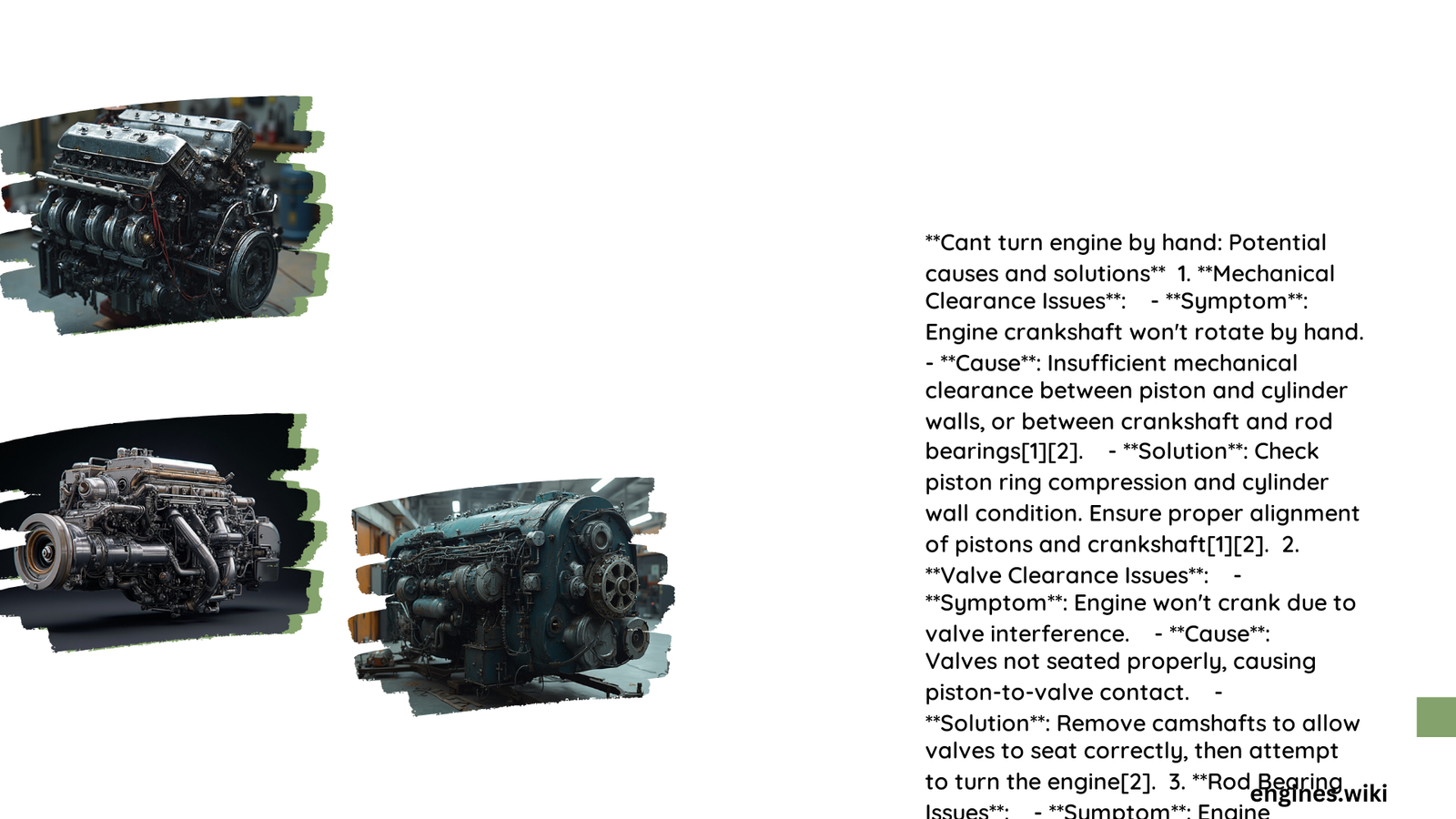When you can’t turn engine by hand, it’s often a sign of serious mechanical issues. This problem typically indicates engine seizure, which can result from low oil levels, overheating, or internal damage. Understanding the causes, symptoms, and solutions for this issue is crucial for vehicle owners and mechanics alike. This article explores the reasons behind an engine that can’t be turned by hand and provides guidance on diagnosis and potential repairs.
What Are the Main Reasons You Can’t Turn Engine by Hand?
The inability to turn an engine by hand is usually a symptom of engine seizure. Here are the primary causes:
-
Low Engine Oil Levels: This is the most common culprit. Insufficient oil leads to increased friction between engine components, causing them to overheat and potentially weld together.
-
Engine Overheating: When an engine overheats, its components can expand beyond their design tolerances, leading to seizure.
-
Broken Timing Belt or Chain: A failure in the timing system can cause pistons to collide with valves, resulting in severe internal damage.
-
Internal Engine Damage: Catastrophic failures, such as thrown connecting rods or cracked cylinder walls, can cause the engine to lock up.
How Can You Diagnose an Engine That Won’t Turn by Hand?

Diagnosing an engine that can’t be turned by hand involves several steps:
- Visual Inspection:
- Check for obvious signs of damage like holes in the engine block or metal shavings in the oil.
-
Look for signs of overheating, such as discolored paint on the engine.
-
Breaker Bar Test:
- Remove the serpentine belt.
- Use a breaker bar on the crankshaft pulley bolt.
-
Attempt to turn the engine in its normal rotation direction.
-
Oil Level Check:
- Ensure the engine oil is at the correct level.
-
Check the oil quality for signs of contamination or degradation.
-
Compression Test:
- If possible, perform a compression test on each cylinder.
- Uneven or zero compression can indicate internal damage.
What Are the Symptoms of a Seized Engine?
A seized engine exhibits several telltale signs:
- Engine won’t crank or start
- Unusual noises when attempting to start (clicks or clunks)
- Burning smell from the engine bay
- Smoke from the engine or exhaust
- Complete loss of engine oil pressure
- Warning lights on the dashboard (oil pressure, check engine)
How Often Do Engines Seize, and What Types Are Most Affected?
Engine seizure frequency varies based on several factors:
- Maintenance History: Poorly maintained engines are more likely to seize.
- Engine Age: Older engines with high mileage are at higher risk.
- Engine Type: Both gasoline and diesel engines can seize, but diesel engines may be more susceptible due to their higher compression ratios.
While exact statistics are hard to come by, it’s estimated that severe engine problems like seizure affect less than 1% of vehicles annually. However, this percentage increases significantly for vehicles with poor maintenance histories.
What Are the Repair Costs for a Seized Engine?
Repairing a seized engine is often expensive and may not be economically viable for older vehicles. Here’s a breakdown of potential costs:
| Repair Option | Estimated Cost Range |
|---|---|
| Engine Rebuild | $2,500 – $4,500 |
| Used Engine Replacement | $3,000 – $7,000 |
| New Engine Replacement | $5,000 – $20,000+ |
Factors affecting cost include:
– Vehicle make and model
– Engine size and complexity
– Labor rates in your area
– Parts availability
How Can You Prevent Engine Seizure?
Preventing engine seizure is primarily about proper maintenance:
- Regular Oil Changes: Follow manufacturer recommendations for oil change intervals.
- Check Oil Levels: Regularly check and top up oil levels.
- Address Overheating: Promptly repair any cooling system issues.
- Timing Belt/Chain Maintenance: Replace timing belts/chains as per manufacturer schedule.
- Regular Inspections: Have your vehicle inspected by a professional periodically.
What Should You Do If You Suspect Engine Seizure?
If you suspect your engine has seized:
- Stop Attempting to Start: Further attempts could cause more damage.
- Tow to a Mechanic: Have the vehicle towed to a reputable mechanic.
- Professional Diagnosis: Allow a professional to diagnose the exact cause.
- Consider Options: Based on the diagnosis, weigh repair options against vehicle value.
Can a Seized Engine Be Repaired?
Whether a seized engine can be repaired depends on the extent of the damage:
- Minor Seizures: Sometimes, if caught early, minor seizures can be resolved by:
- Removing spark plugs
- Applying penetrating oil to cylinders
-
Attempting to turn the engine manually after a waiting period
-
Major Seizures: Often require:
- Complete engine teardown
- Replacement of damaged components
- In many cases, full engine replacement
The decision to repair or replace depends on:
– Extent of damage
– Cost of repair vs. replacement
– Vehicle age and value
Remember, attempting to repair a seized engine without proper knowledge and tools can lead to further damage. Always consult with a professional mechanic when dealing with serious engine issues like seizure.
